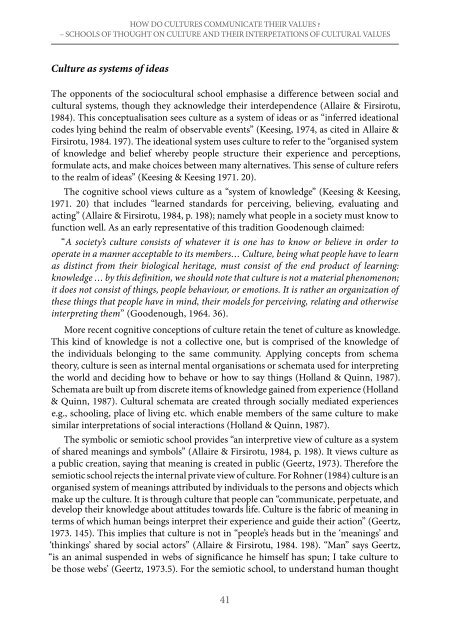ACTA SZEKSZARDIENSIUM - Pécsi Tudományegyetem Illyés Gyula ...
ACTA SZEKSZARDIENSIUM - Pécsi Tudományegyetem Illyés Gyula ...
ACTA SZEKSZARDIENSIUM - Pécsi Tudományegyetem Illyés Gyula ...
Create successful ePaper yourself
Turn your PDF publications into a flip-book with our unique Google optimized e-Paper software.
HOW DO CULTURES COMMUNICATE THEIR VALUES ?<br />
– SCHOOLS OF THOUGHT ON CULTURE AND THEIR INTERPETATIONS OF CULTURAL VALUES<br />
Culture as systems of ideas<br />
The opponents of the sociocultural school emphasise a difference between social and<br />
cultural systems, though they acknowledge their interdependence (Allaire & Firsirotu,<br />
1984). This conceptualisation sees culture as a system of ideas or as “inferred ideational<br />
codes lying behind the realm of observable events” (Keesing, 1974, as cited in Allaire &<br />
Firsirotu, 1984. 197). The ideational system uses culture to refer to the “organised system<br />
of knowledge and belief whereby people structure their experience and perceptions,<br />
formulate acts, and make choices between many alternatives. This sense of culture refers<br />
to the realm of ideas” (Keesing & Keesing 1971. 20).<br />
The cognitive school views culture as a “system of knowledge” (Keesing & Keesing,<br />
1971. 20) that includes “learned standards for perceiving, believing, evaluating and<br />
acting” (Allaire & Firsirotu, 1984, p. 198); namely what people in a society must know to<br />
function well. As an early representative of this tradition Goodenough claimed:<br />
“A society’s culture consists of whatever it is one has to know or believe in order to<br />
operate in a manner acceptable to its members… Culture, being what people have to learn<br />
as distinct from their biological heritage, must consist of the end product of learning:<br />
knowledge … by this definition, we should note that culture is not a material phenomenon;<br />
it does not consist of things, people behaviour, or emotions. It is rather an organization of<br />
these things that people have in mind, their models for perceiving, relating and otherwise<br />
interpreting them” (Goodenough, 1964. 36).<br />
More recent cognitive conceptions of culture retain the tenet of culture as knowledge.<br />
This kind of knowledge is not a collective one, but is comprised of the knowledge of<br />
the individuals belonging to the same community. Applying concepts from schema<br />
theory, culture is seen as internal mental organisations or schemata used for interpreting<br />
the world and deciding how to behave or how to say things (Holland & Quinn, 1987).<br />
Schemata are built up from discrete items of knowledge gained from experience (Holland<br />
& Quinn, 1987). Cultural schemata are created through socially mediated experiences<br />
e.g., schooling, place of living etc. which enable members of the same culture to make<br />
similar interpretations of social interactions (Holland & Quinn, 1987).<br />
The symbolic or semiotic school provides “an interpretive view of culture as a system<br />
of shared meanings and symbols” (Allaire & Firsirotu, 1984, p. 198). It views culture as<br />
a public creation, saying that meaning is created in public (Geertz, 1973). Therefore the<br />
semiotic school rejects the internal private view of culture. For Rohner (1984) culture is an<br />
organised system of meanings attributed by individuals to the persons and objects which<br />
make up the culture. It is through culture that people can “communicate, perpetuate, and<br />
develop their knowledge about attitudes towards life. Culture is the fabric of meaning in<br />
terms of which human beings interpret their experience and guide their action” (Geertz,<br />
1973. 145). This implies that culture is not in “people’s heads but in the ‘meanings’ and<br />
‘thinkings’ shared by social actors” (Allaire & Firsirotu, 1984. 198). “Man” says Geertz,<br />
“is an animal suspended in webs of significance he himself has spun; I take culture to<br />
be those webs’ (Geertz, 1973.5). For the semiotic school, to understand human thought<br />
41




